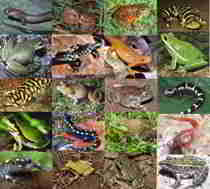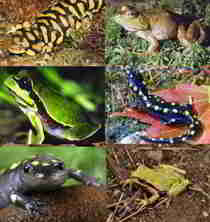
Georgia Symbols
Georgia State Amphibian
Green Tree Frog
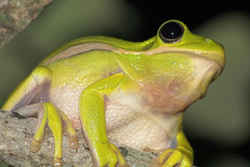
(Hyla cinerea)
Adopted on May 9, 2005
The Green Tree Frog became Georgia's State Amphibian during the 2005 legislative session, making it the newest state symbol.
The State of Georgia is home to 85 different species of amphibians, which gives it the distinction of having the second greatest amphibian diversity of any state in the United States behind North Carolina. Senate Bill 41, sponsored by Sen. Preston Smith and signed into law May 9, 2005 by Gov. Sonny Perdue, designated the Green Tree Frog as the official state amphibian of Georgia.
There are two species of tree frog commonly found in Georgia. Senate Bill No. 41 referred to Hyla cinera in section 1. Unfortunately, no species was noted in section 2, amending Article 3 of Chapter 3 of Title 50 of the Official Code of Georgia Annotated. Though not specified by statute, we might assume that Hyla cinera was the intended species.
Georgia State Amphibian: Green Tree Frog
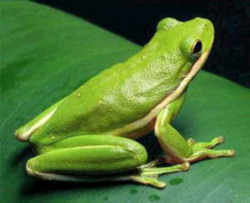
Green tree frogs are a beautiful species of frogs. The males are usually slightly smaller as compared to the females. Moreover, the wrinkled throat (an indication of the vocal pouch) is a feature that is common only among the males. The green tree frog is a 2-inch lime-green frog with a white stripe down each side. It eats bugs and lives mostly in trees, but also has the ability to climb and cling to smooth surfaces like windows and sliding glass doors. According to the bill, the green tree frog's (hyla cinerea) habitat includes nearly all of Georgia, so virtually all Georgians are familiar with the amphibian or have a great opportunity to see its conspicuous bright color and striped markings. The green tree frog is also recognized for its large aggregations of calling males that create conspicuous and characteristic nighttime choruses during the warm months in Georgia.
Characteristics of Georgia's Green Tree Frog
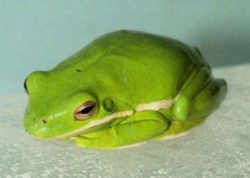
- Size: These medium-sized frogs roughly around 6 centimeters (2.5 inches) length wise.
- Color: The green shade of their body may vary from a startling bright yellow olive to a distinct lime green. It is important
to remember that the temperature or lighting largely affects the darkness or tone of the color change.
One can also notice miniature gold or white patches on the frog's skin. The pale yellow or creamy white line that runs down from its jaw right up to its groin is also a distinct feature.
The area of the abdomen is generally pale yellow or white in color. - Toe Pads: Characteristic to most tree frogs, the green tree frog also has large toe pads.
- Habits: Green Treefrogs are generally arboreal and spend much of their lives in trees. They are also frequently encountered near porch and patio lights throughout the south during warm, wet weather; they enjoy the abundant supply of insects attracted to the light. They are nocturnal animals and males call while perched on plants adjacent to water (up to 5m high) or from floating vegetation. The calling season extends from March to October. This species is more resistant to fish than many amphibian species in Georgia
- Range: The Green Treefrog is abundant throughout the Coastal Plain and is also found in the Piedmont of Georgia.
- Habitat: Green treefrogs are frequently found in small ponds, large lakes, marshes, and streams. They prefer habitats with plentiful floating vegetation, grasses, and cattails. One study suggested that, in an artificial hardwood forest setting, the abundance of Hyla cinerea is related to the openness of the forest canopy. The study noted that 88% of 331 individuals were found in areas of the forest where the canopy was open. The presence of green treefrogs in the open canopy areas was interpreted as a method for finding prey, which concentrate in sunny areas with dense ground vegetation. (Horn, et al., 2004; Martof, et al., 1980)
- Diet: The green tree frogs love to feed on insects of all kinds. As such their diet comprises of mosquitoes, flies, and smaller insects. It is also very interesting to note that these frogs have a huge preference for the kind of prey that is highly active; the prey size does not come into account.
- Green Tree Frog Call: The call of the male green tree frog can be usually heard on humid, overcast nights. Its call comprises of a series of "quonks"or "queenk-queenk-queenks"sounds.
- Life Cycle and Reproduction: This frog breeds from March through October. Fertilization is external. Females lay up to 400 eggs in shallow water with aquatic vegetation. Hatching occurs within a week and transformation occurs in two months. Calling and egg-laying are particularly frequent after rainstorms.
Georgia Senate Bill 41
On May 9, 2005, Governor Sonny Purdue signed Senate Bill No. 41 into law making the green tree frog the "official Georgia state amphibian.
05 LC 28 1909
By: Senator Smith of the 52nd
PASSED
A BILL TO BE ENTITLED
AN ACT
To amend Article 3 of Chapter 3 of Title 50 of the Official Code of Georgia Annotated, relating to state symbols, so as to designate the green tree
frog as the official state amphibian; to provide for legislative findings; to provide for related matters; to repeal conflicting laws; and for other
purposes.
BE IT ENACTED BY THE GENERAL ASSEMBLY OF GEORGIA:
SECTION 1.
The General Assembly finds and determines that:
(1) The green tree frog's (hyla cinerea) habitat includes nearly all of Georgia, so virtually all Georgians are familiar with it or have a great opportunity
to see its conspicuous bright color and striped markings;
(2) Large aggregations of calling males create conspicuous and characteristic nighttime choruses during the warm months;
(3) All other major groups of wildlife, including mammals, birds, reptiles, fish, insects, trees, and wildflowers, are represented by state symbols,
and amphibians are a crucial link in the state's ecosystem;
(4) Official recognition of a state amphibian could help correct the false impression that amphibians and reptiles are one and the same;
(5) The State of Georgia is home to 85 different species of amphibians, which gives it the distinction of having the second greatest amphibian diversity
of any state in the United States behind North Carolina;
(6) Well-publicized world-wide decline of amphibians has become a major conservation concern and the exclusion of amphibians from our official state
symbols list could possibly contribute to a sense of complacency towards this loss of biota;
(7) Amphibians are excellent indicators of water and air quality due to their porous skin and habit of moving between aquatic and terrestrial habitats,
and declines in their numbers can serve as early warning signs that environmental conditions may be deteriorating in localized areas; and
(8) Establishing an official state amphibian is necessary to fully recognize our diverse wildlife and the green tree frog is deserving of the attention
and appreciation of the citizens of this state by designation as the official state amphibian.
SECTION 2.
Article 3 of Chapter 3 of Title 50 of the Official Code of Georgia Annotated, relating to state symbols, is amended by adding a new Code Section 50-3-81
to read as follows:
"50-3-81.
The green tree frog is designated as the official Georgia state amphibian."
SECTION 3.
All laws and parts of laws in conflict with this Act are repealed.
Georgia Law
The law designating the green tree frog as the official Georgia state game amphibian is Section 50-3-81 (Official amphibian) of the Georgia Code Title 50 (STATE GOVERNMENT) Chapter 3 (STATE FLAG, SEAL, AND OTHER SYMBOLS ) SECTION 50-3-81.
TITLE 50. STATE GOVERNMENT
CHAPTER 3. STATE FLAG, SEAL, AND OTHER SYMBOLS
ARTICLE 3. OTHER STATE SYMBOLS
O.C.G.A.§ 50-3-81 (2007)
§ 50-3-81. Official amphibian
The green tree frog is designated as the official Georgia state amphibian.
HISTORY: Code 1981, § 50-3-81, enacted by Ga. L. 2005, p. 316, §2/SB 41.
Taxonomic Hierarchy: Green Tree Frog
Kingdom: Animalia - animals
Phylum: Chordata
Subphylum: Vertebrata
Class: Amphibia
Order: Anura
Family: Hylidae
Genus: Hyla
Species: Hyla cinerea
